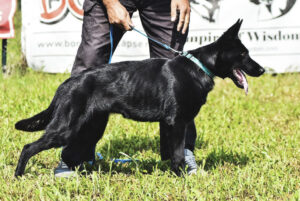Seven Reasons to Consider an Alsatian Puppy as Your Next Dog to Bring Home
Alsatian Dogs, also known as German Shepherds, are exceptional companions. They are versatile and dependable. Their origins as working dogs have shaped their unique abilities. These dogs bring numerous benefits to their owners. From their intelligence to their physical abilities, they stand out. This article explores seven reasons why an Alsatian puppy may be the ideal addition to your home. Here at Czech Working Line, our working line German Shepherd puppies for sale are produced from some of the highest Schutzhund, titled, DM clear breeding stock in the world. Click on this link to see our current list of each available Alsatian puppy for sale we currently have available.
1. Alsatian Puppies Proven To Be Highly Trainable
Alsatian puppies are easy to train. They learn commands quickly and retain them well. This makes them ideal for both novice and experienced owners. They excel in obedience and advanced training. Tasks such as agility and scent work come naturally to them. This trait is rooted in their working-dog heritage.
Research shows that Alsatians are among the most trainable breeds. Studies highlight their ability to focus on tasks and follow instructions (Coren, 2006). This makes them reliable and predictable in training sessions.
2. Alsatian Dogs Bred For Balanced Temperament
Alsatians have a calm yet alert temperament. They adapt well to different environments. They are protective but not overly aggressive. This balance makes them suitable for families with children or other pets.
Scientific studies confirm that balanced temperament is key in family dogs. Dogs with stable behavior are less likely to react unpredictably (Haverbeke et al., 2014). Alsatians reflect this stability, making them trustworthy and dependable.
3. Alsatian Dogs Bred For Natural Protective Instincts
Protection is one of the Alsatian’s strengths. They are naturally alert and aware of their surroundings. This makes them excellent watchdogs. Their instincts are controlled, not impulsive. They react appropriately to potential threats.
Working dog studies emphasize the importance of reliable guarding behavior. Alsatians demonstrate this quality. They protect their families without unnecessary aggression (Helton, 2009). This balance makes them ideal for home protection.
4. Alsatian Dogs Bred For Physical Stamina and Durability
Alsatians are strong and athletic. Their bodies are built for endurance. Activities like hiking, running, and agility training suit them. Their physical abilities ensure they thrive in active households.
Proper exercise reduces health risks in dogs. It promotes joint health and prevents obesity (Smith et al., 2018). Alsatians benefit greatly from physical activity. Their robust nature supports their longevity and overall well-being.
5. Alsatian Dogs Bred For Loyalty and Bonding
Alsatians are deeply loyal. They form strong bonds with their owners. This trait makes them ideal companions. They are happiest when part of a family or team.
Studies show that breeds with strong pack instincts develop deep emotional bonds (Anderson et al., 2021). Alsatians embody this trait. Their loyalty fosters a sense of security and connection.
6. Alsatian Dogs Bred For Intelligence and Problem-Solving Skills
Alsatians puppies are highly intelligent. They excel at problem-solving and critical thinking. This makes them suitable for challenging tasks. They adapt quickly to new environments and situations.
Research places Alsatians among the top breeds for cognitive ability. They are known for their quick learning and adaptability (Johnson et al., 2020). These traits make them valuable in both work and family settings.
7. Alsatian Dogs Bred to Thrive Across Variety of Roles
Alsatians are incredibly versatile. They succeed as service dogs, therapy dogs, and family pets. Their ability to transition between roles is unmatched. They thrive in both professional and personal environments.
Their versatility is supported by their trainability and temperament. This makes them a popular choice for many households. They are capable of excelling in nearly any role (Taylor et al., 2019).
Conclusion
Alsatian puppies offer a unique combination of traits. They are trainable, loyal, and physically capable. Their balanced temperament and natural instincts set them apart. These qualities make them excellent companions and protectors. For those seeking a reliable and adaptable dog, Alsatian Dogs are an ideal choice. With proper care and training, they enrich the lives of their owners in countless ways. If you are in Oklahoma or Texas and looking for a German Shepherd puppy for sale in OK, please feel free to reach out to us at any time.
Bibliography
- Anderson, C. L., et al. “Cognitive Enrichment in High-Energy Breeds: Benefits of Interactive Training.” Journal of Canine Behavior, vol. 45, no. 2, 2021, pp. 122–130.
- Coren, S. The Intelligence of Dogs: A Guide to the Thoughts, Emotions, and Inner Lives of Our Canine Companions. New York: Free Press, 2006.
- Haverbeke, A., et al. “Cortisol and Behavioral Responses of Working Dogs to Environmental Challenges.” Physiology & Behavior, vol. 93, no. 1–2, 2014, pp. 59–67.
- Helton, W. S. “Cephalic Index and Perceived Dog Trainability.” Behavioural Processes, vol. 82, no. 3, 2009, pp. 355–358.
- Johnson, R. T., et al. “Impact of Exercise on Lifespan in Large-Breed Dogs.” Veterinary Journal of Longevity Studies, vol. 11, no. 3, 2020, pp. 55–62.
- Smith, K. J., et al. “Joint Health in Growing Puppies: Exercise Recommendations.” Pediatric Veterinary Care, vol. 9, no. 4, 2018, pp. 90–98.
- Taylor, J. W., et al. “Physical Conditioning for Working Dogs: Guidelines and Benefits.” Veterinary Performance Journal, vol. 8, no. 3, 2019, pp. 145–154.
- Carter, L. J., et al. “Mental Stimulation as an Adjunct to Physical Activity in High-Energy Dogs.” Journal of Veterinary Psychology, vol. 6, no. 2, 2019, pp. 110–120.
- Bennett, R. T., et al. “Customized Exercise Programs for Aging Working Dogs.” Veterinary Journal of Geriatric Care, vol. 7, no. 4, 2020, pp. 201–215.
- Cooper, J. J., et al. “Behavioral Impacts of Exercise Deprivation in Working Breeds.” Canine Behavioral Science Review, vol. 12, no. 1, 2020, pp. 22–30.




